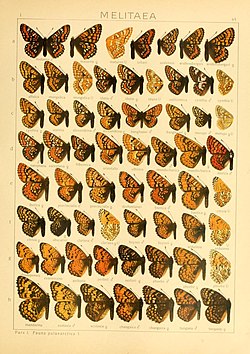Description
Difficult to distinguish from some aurinia forms. Tusov treats orientalis as a subspecies of Arinia. [3]
Seitz: "orientalis H.-Schaff. (65d) is apparently a combination of the two previous [subspecies of aurinia- pellucida Christ. [E. aurinia pellucida (Christoph, 1893)], from the Caucasus (recognizable by the thin scaling, in consequence of which all the colours appear paler and the wings slightly transparent. The markings, however, are as abundant as the colours are weak and inconspicuous) and laeta Christ [E. aurinia laeta (Christoph, 1893)]( differs from the preceding in the denser scaling and more conspicuous colours, the upperside having a rather chequered appearance in consequence of the strongly developed and several times curved black discal bands; from the Vilui Mts. in Siberia] the upperside being as bright and variegated as in laeta, while the underside is as pale, dull and uniform in colour as in pellucida. Asia Minor and Armenia to Kurdistan." [4]
This page is based on this
Wikipedia article Text is available under the
CC BY-SA 4.0 license; additional terms may apply.
Images, videos and audio are available under their respective licenses.
